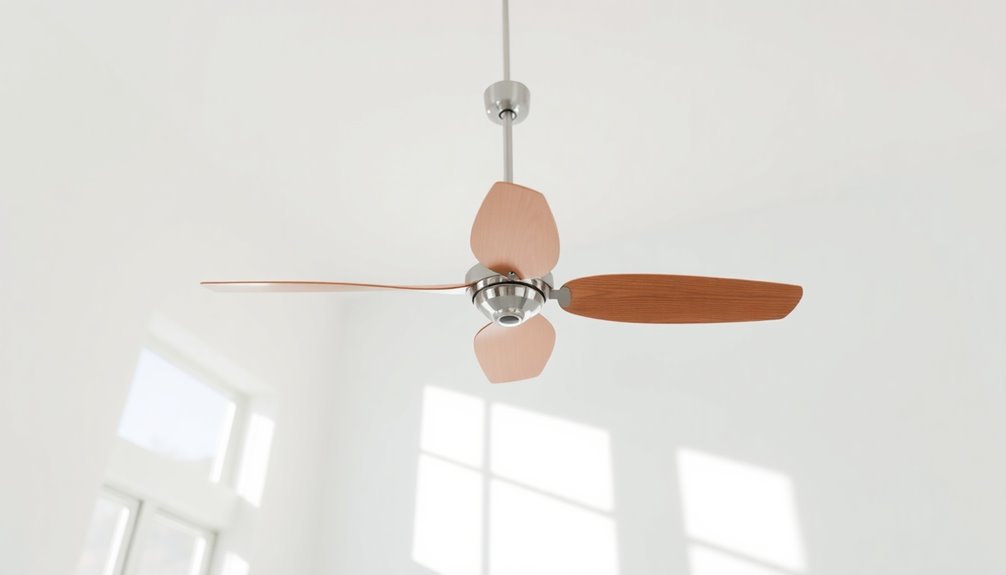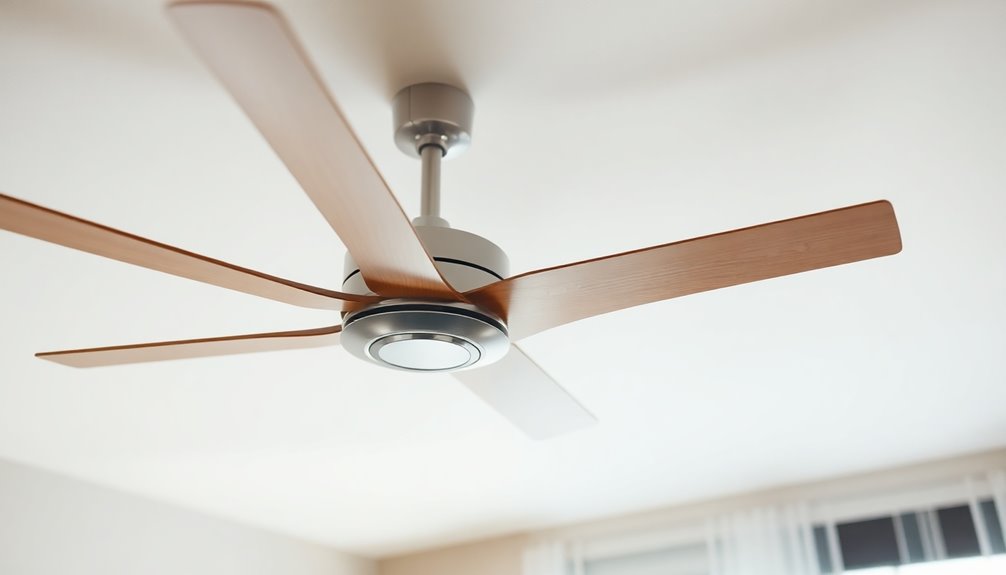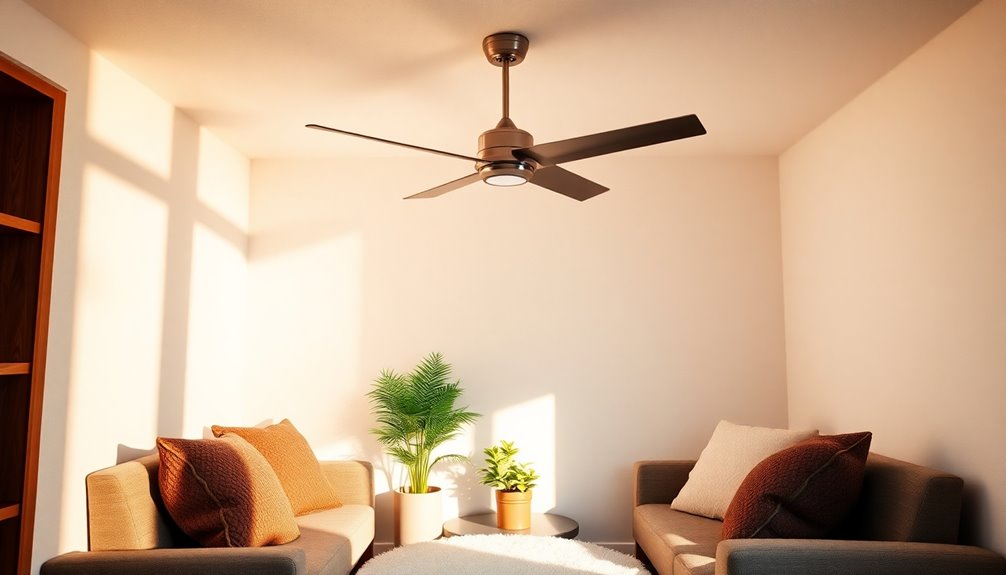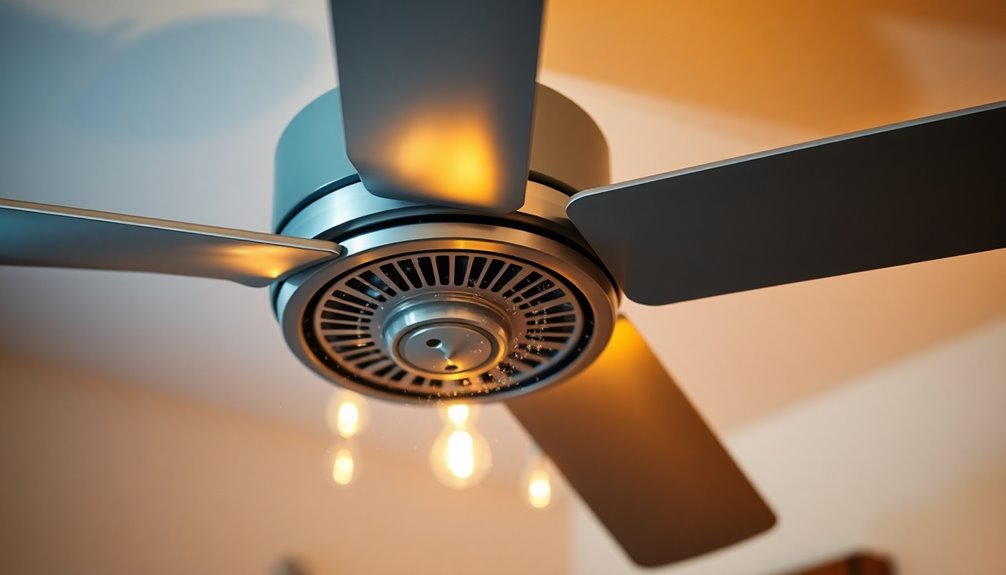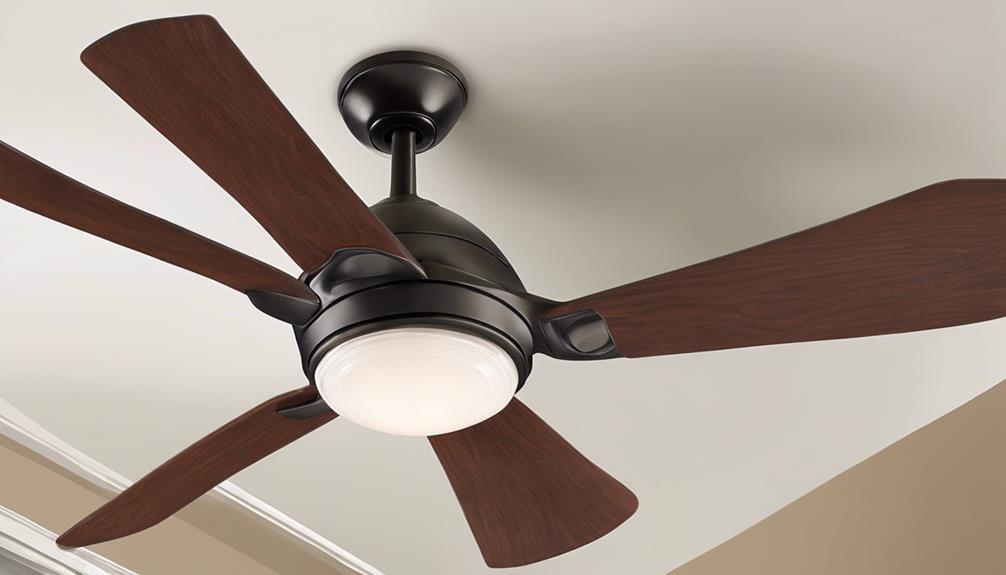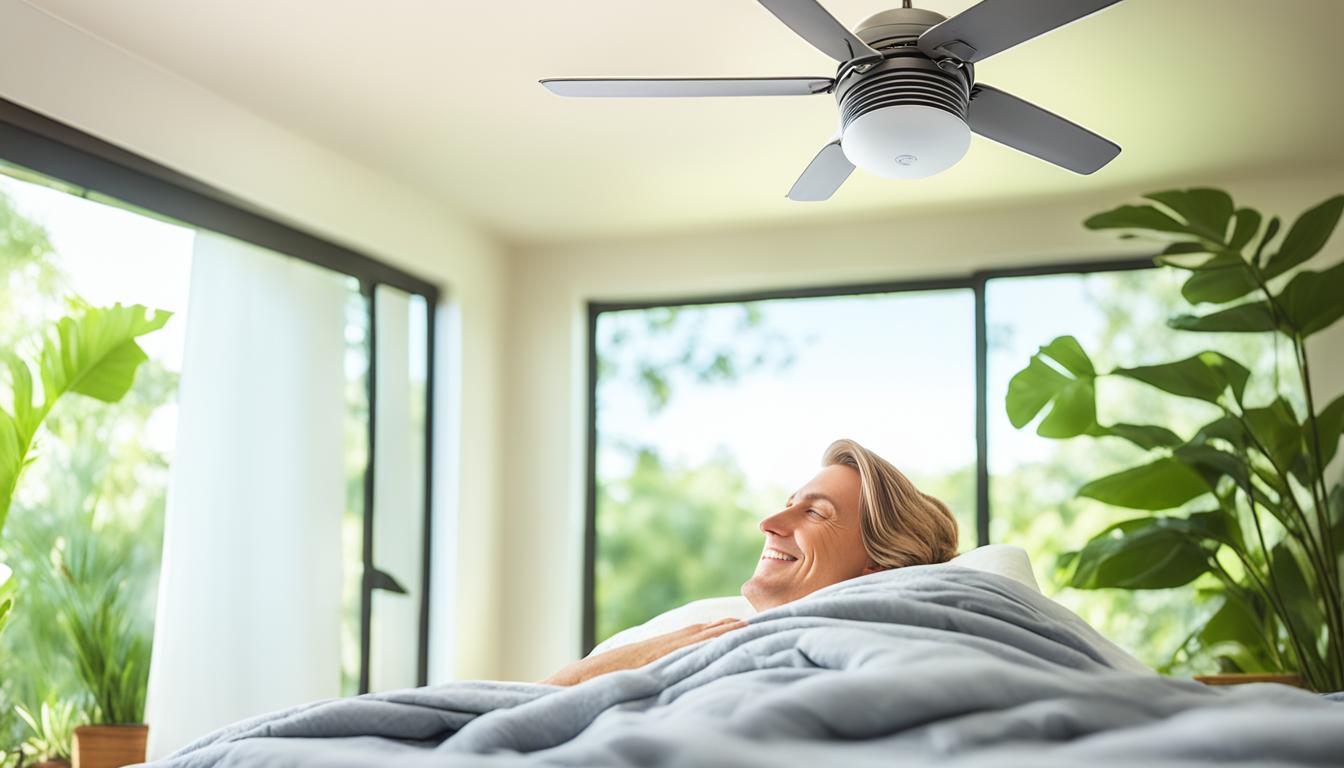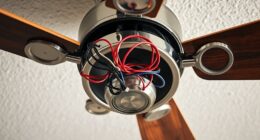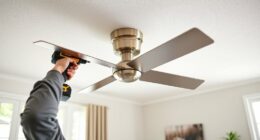The number of blades on your ceiling fan does matter, as it can affect both performance and style. Typically, three-blade fans offer a sleek look and can move air quickly, making them great for larger spaces. In contrast, five-blade fans provide smoother airflow and quieter operation, ideal for residential areas. While airflow efficiency is similar, noise levels rely more on blade pitch and motor power than just the count of blades. So, consider room size and your design preferences when choosing. Exploring these factors further might help you make the perfect selection for your home.
Key Takeaways
- The number of blades affects the fan's aesthetic and noise levels rather than airflow efficiency, which remains similar across different blade counts.
- Three-blade fans are better for modern designs and larger spaces due to their high-speed potential, while five-blade fans offer quieter operation.
- Five-blade fans are more effective in larger areas as they create steadier airflow and are generally quieter for residential environments.
- Innovations have allowed two-blade fans to perform comparably to traditional fans, challenging the conventional belief that more blades are better.
- When choosing a fan, consider blade count alongside motor power and blade pitch to ensure optimal performance for the designated space.
Understanding Ceiling Fan Blade Counts

When choosing a ceiling fan, understanding blade counts is essential, as it can greatly impact both the fan's aesthetics and its performance. The number of blades on a ceiling fan typically ranges from three to five, with each configuration offering unique design elements.
Three-blade fans are often favored for their sleek, modern look and powerful airflow, making them perfect for small to medium rooms. If you value energy efficiency and quieter operation, five-blade fans strike a balance between effective air circulation and aesthetics, making them ideal for medium to large spaces.
While it might seem that more blades equate to better ceiling fan performance, the reality is that the differences in airflow efficiency among various blade counts are generally minimal. More blades can create smoother airflow and reduce noise, but fewer blades can achieve higher speeds due to less drag.
Ultimately, your personal preference for style and design plays a significant role in your choice. Whether you lean towards the contemporary vibe of three-blade fans or the classic appeal of five blades, understanding these aspects will help you make an informed decision that fits your space.
Performance Impact of Blade Count

The impact of blade count on ceiling fan performance often gets overshadowed by other factors like motor power and blade pitch.
While you might think more blades mean better airflow efficiency, that's not necessarily the case. Here are a few key points to ponder:
- Three Blades: These fans typically have a high-speed potential due to reduced drag, making them excellent for powerful air circulation.
- Four Blades: Often provide smoother and quieter airflow, ideal for residential settings where noise reduction is a priority.
- Advanced Design: Innovations allow two-blade fans to perform comparably to those with more blades, reducing the significance of blade count on performance.
- Aesthetics: Blade count primarily influences the fan's look, with consumer preferences heavily guiding the choice of configuration.
Room Size Considerations

When choosing a ceiling fan, room size plays a vital role in your decision.
For small rooms, a 3-blade fan can provide powerful airflow without overwhelming the space.
In larger areas, a 5-blade fan is often more efficient, ensuring air circulates effectively throughout the room.
Small Room Preferences
Selecting the right ceiling fan for a small room can greatly enhance your comfort and style. When choosing between 3-blade and 5-blade fans, consider the following:
- Airflow: 3-blade fans provide powerful airflow with minimal drag, making them ideal for effective cooling in small rooms.
- Aesthetics: 3-blade fans often feature a modern design that complements minimalist decor, enhancing the visual appeal of your space.
- Noise Levels: If you're in a noise-sensitive environment, 5-blade fans are typically quieter, focusing on smoother airflow without disturbing your peace.
- Personal Preferences: Ultimately, your choice should reflect your priorities—whether you prefer intense airflow from a 3-blade fan or a quieter operation from a 5-blade fan.
For small rooms, 3-blade fans offer a balance between performance and aesthetics, delivering effective cooling without overwhelming the space. Additionally, modern Energy Star certified fans can raise thermostat temp by 4°F, further improving energy efficiency.
On the other hand, if you value a calm atmosphere, a 5-blade fan might be the better fit.
Whichever you choose, make sure it aligns with your personal preferences to create the ideal environment.
Large Room Efficiency
For larger rooms, choosing the right ceiling fan can drastically improve air circulation and comfort levels. If your space exceeds 400 sq. ft., a 5-blade ceiling fan with a powerful motor is your best bet. This setup guarantees effective airflow, enhancing cooling performance throughout the room.
When dealing with expansive areas, consider fans with higher blade counts, like 8 or 12 blades. These fans create steadier airflow, which is vital for maintaining a consistent temperature. If your ceilings are over 9 ft., opting for fans with more blades will maximize airflow coverage, making sure every corner of your large room feels comfortable.
Remember, the blade count can greatly impact energy consumption. While more blades can lead to smoother airflow, they may require a more powerful motor to overcome drag and maintain efficiency.
It's important to strike a balance between blade count and motor power to optimize energy use.
Aesthetic Preferences in Fan Design

Aesthetic preferences play an essential role in choosing the right ceiling fan, as the number of blades can greatly influence a room's overall style. The blade count not only impacts functionality but also contributes to the fan's visual appeal.
Here are some considerations to keep in mind:
- 3-blade fans: These provide a minimalist look, perfect for modern interior designs, offering a sleek and uncluttered aesthetic.
- 4-blade fans: These add visual weight, making them ideal for traditional or ornate styles, enhancing the overall décor of your space.
- Two-blade fans: For those seeking a bold design statement, these fans bring a unique and unconventional flair to your room.
- Fans with six or more blades: These can complement industrial themes, introducing a more robust and visually interesting appearance.
Additionally, asymmetrical arrangements and varied blade lengths in fan design can introduce artistic flair, transforming your ceiling fan into a focal point.
Whatever your aesthetic preferences, choosing the right blade count guarantees your ceiling fan not only cools the room but also enhances its style.
Comparing Blade Counts: 3 vs. 5

When choosing between a three-blade and a five-blade ceiling fan, consider how each impacts airflow efficiency, noise levels, and design aesthetics.
Three-blade fans excel in speed and energy efficiency, making them great for smaller spaces.
On the other hand, five-blade fans offer smoother airflow and a quieter experience in larger rooms.
Your choice will depend on your specific needs and the style you want to achieve.
Airflow Efficiency Comparison
Ceiling fans often vary in blade count, and you'll frequently find yourself weighing the benefits of 3-blade versus 5-blade designs.
When it comes to airflow efficiency, both options have their merits, depending on your specific needs. Here's a quick comparison:
- 3-Blade Fans: Typically designed for higher speeds, these fans experience less drag, resulting in powerful airflow suitable for smaller spaces.
- 5-Blade Fans: With increased surface area, they offer a smoother and quieter airflow, making them ideal for larger rooms where noise reduction matters.
- CFM Efficiency: Surprisingly, the airflow efficiency (measured in CFM) doesn't differ much between the two. Modern fan technology guarantees effective performance across blade counts.
- Design Versatility: If aesthetics matter, 3-blade fans often fit minimalist designs, while 5-blade fans can blend well with various decor styles.
Ultimately, whether you choose 3-blade or 5-blade fans should depend on your preferences for airflow intensity, noise levels, and design compatibility rather than a strict performance metric.
Both can deliver effective airflow, but your specific needs will guide your choice.
Noise Level Considerations
Choosing between a 3-blade and a 5-blade ceiling fan can greatly impact the noise level in your space. While three-blade fans often deliver powerful airflow, they can generate more noise due to increased drag. On the other hand, five-blade fans are designed for smoother airflow, offering a quieter performance that many homeowners appreciate.
| Blade Count | Airflow Performance | Noise Level | Recommended Use |
|---|---|---|---|
| 3 Blades | High | Moderate | Large spaces |
| 5 Blades | Moderate | Low | Residential areas |
The difference in noise levels is usually minimal, especially with modern designs that prioritize quiet operation. Factors like blade pitch and motor power play a more significant role in noise than the number of blades. Fans with well-angled blades and efficient motors tend to operate more quietly, regardless of how many blades they have. If you're looking for a serene environment, five-blade fans are often the best choice, particularly in spaces where noise can disrupt comfort and ambiance.
Aesthetic Design Choices
The design of a ceiling fan can considerably influence the overall aesthetic of your space, especially when comparing three-blade and five-blade options.
Choosing the right blade count is essential for matching your ceiling fan design to your aesthetic preferences. Here are some key points to evaluate:
- Three-Blade Fans: They often feature a minimalist design that complements modern aesthetics, creating a sense of openness in a room. Additionally, these fans tend to be more energy-efficient, which can contribute to reducing cooling costs in the long run. The average price range for ceiling fans can also affect your decision, as three-blade models may often be more budget-friendly. Furthermore, the noise levels of modern heat pumps can also impact the overall comfort of a room, making quieter fans a beneficial choice.
- Five-Blade Fans: These fans provide smoother airflow and quieter operation, making them ideal for traditional design styles.
- Visual Weight: More blades can create visual weight, enhancing the appeal in spaces with classic decor, while fewer blades emphasize a sleek, contemporary look.
- Noise Levels: Three-blade fans typically produce more airflow but can be noisier due to less drag, while five-blade fans tend to operate quietly.
Moreover, selecting a ceiling fan that aligns with energy-efficient designs can enhance both comfort and sustainability in your living space.
Ultimately, your choice between three and five blades should align with your aesthetic preferences and the overall design theme of your space.
Both options are effective in functionality, but the right blade count will enhance your room's visual harmony.
Making an Informed Decision

When it comes to selecting a ceiling fan, understanding the number of blades is just one piece of the puzzle. A common misconception is that blade count alone dictates airflow efficiency and fan performance. In reality, factors like motor power and blade pitch play a more significant role.
For instance, modern 3-blade fans can deliver high-speed airflow with less drag, while 5-blade fans often provide a smoother and quieter operation.
To make an informed decision, evaluate your specific needs. If you're focused on airflow efficiency, check the CFM (Cubic Feet per Minute) ratings, which offer a clearer picture of a fan's performance than blade count alone.
Additionally, consider how the fan's design style fits within your space. Consulting with ceiling fan experts can also help you understand which fan suits your aesthetic preferences and functional requirements.
Ultimately, while blade count can influence the look of your ceiling fan, it's the combination of motor strength, blade pitch, and CFM that truly determines how well your fan will perform.
Choose wisely, and you'll find the perfect balance between style and functionality.
Frequently Asked Questions
Are 5 Blades Better Than 3 on a Fan?
When you're deciding if 5 blades are better than 3 on a fan, it really depends on your preferences and room size.
Five blades often provide smoother airflow and quieter operation, making them great for larger spaces.
However, three blades can offer higher speeds and powerful circulation.
Ultimately, consider factors like airflow efficiency, noise levels, and the design that fits your style before making a choice; it's not just about the blade count.
How Many Blades Are Better on a Ceiling Fan?
When it comes to ceiling fans, think of blades as the wings of a bird, each contributing to the flight's grace.
You might wonder how many blades are better. If you're after a powerful breeze for a small to medium room, three blades do the trick.
However, if you need a smoother, quieter experience in larger spaces, five blades are your best bet.
Ultimately, consider the room size and desired airflow when choosing.
Which Is Better, a 3 or 4 Blade Ceiling Fan?
When deciding between a 3 or 4-blade ceiling fan, consider your specific needs.
If you want powerful airflow and don't mind a bit of noise, a 3-blade fan might be your best bet.
However, if you prefer a quieter operation and smoother airflow, especially in larger rooms, go for a 4-blade fan.
Ultimately, it's about balancing airflow efficiency, noise levels, and the aesthetic you want in your space.
Is a 3-Blade or 5-Blade Pedestal Fan Better?
When it comes to choosing between a three-blade and a five-blade pedestal fan, you're in for a whirlwind of options!
If you crave powerful airflow, a three-blade fan might just blow you away with its speed.
However, if you prefer a whisper-quiet experience, the five-blade fan delivers smooth, gentle breezes.
Consider your room size and design style, and you'll find the perfect fan that suits your comfort needs and aesthetic.
Conclusion
When choosing a ceiling fan, the number of blades can play a role, but it's not the only factor to take into account. Curiously, studies show that fans with five blades can be up to 30% quieter than those with three. So, think about your room size, design preferences, and desired airflow before making a decision. Ultimately, it's about finding the right balance between style and function to keep your space comfortable and inviting.
